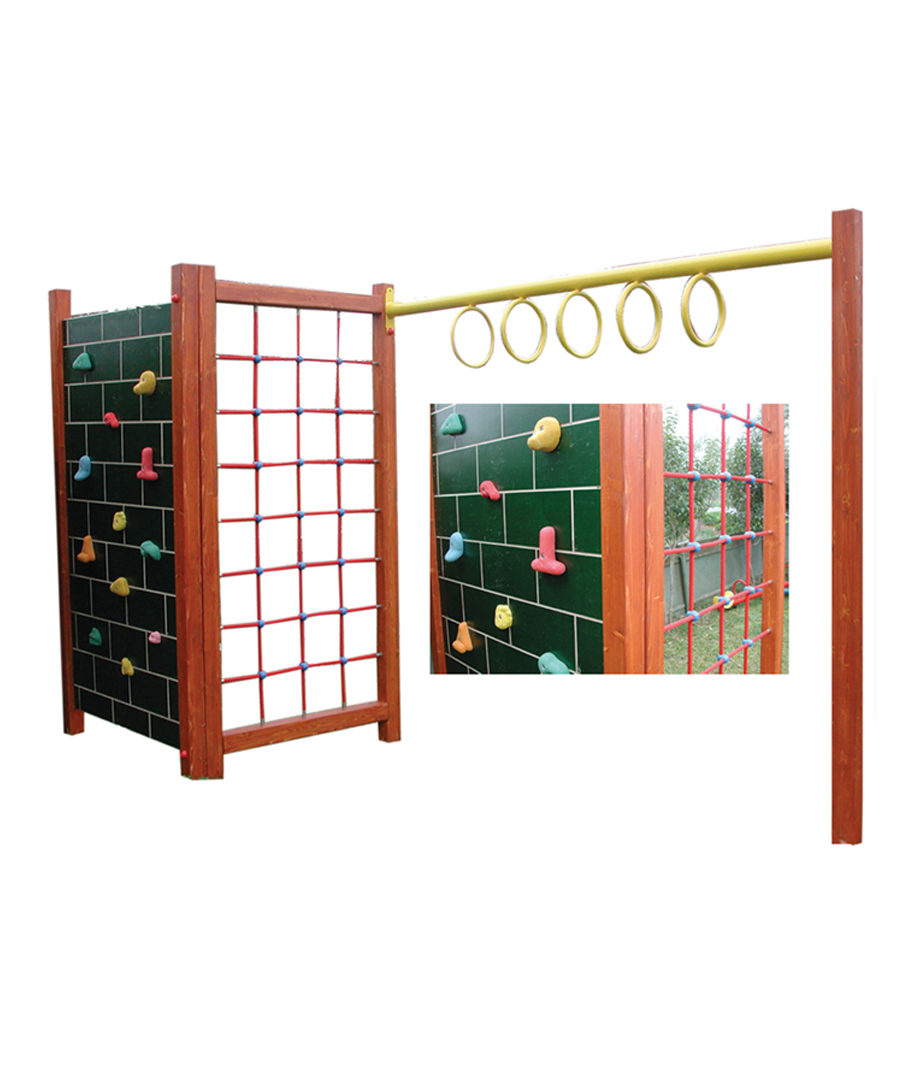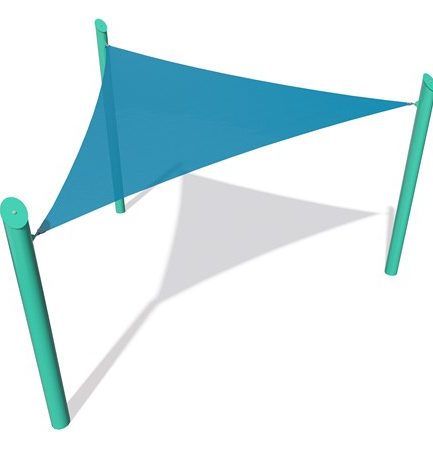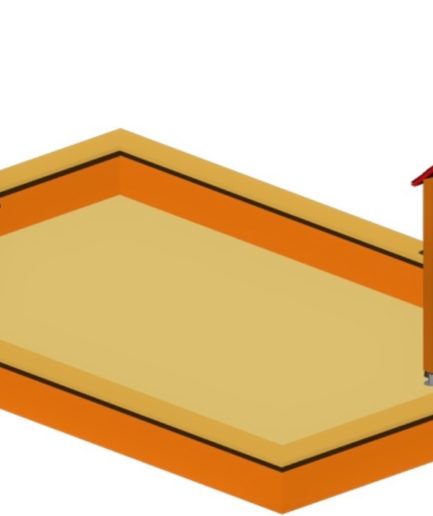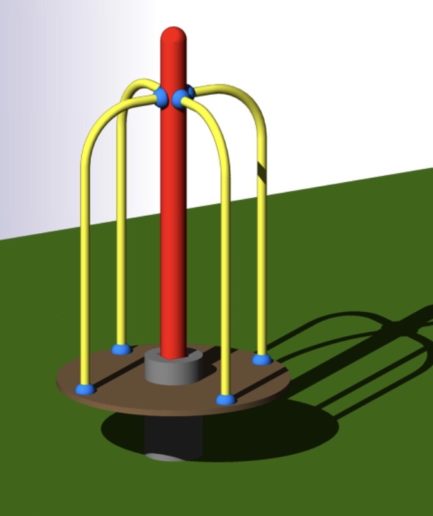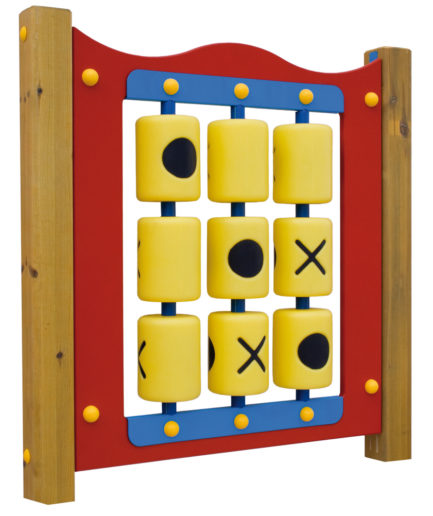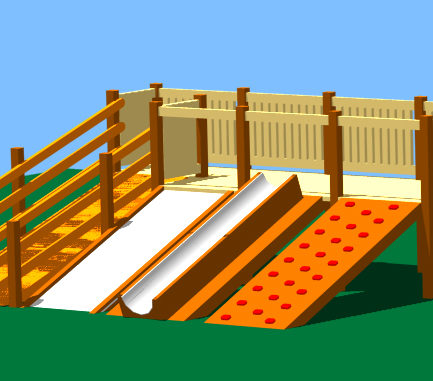CLIMBING FRAMES 10-06-02
10-06-02
The instrument has a total dimensions of 150×385 cm and a height of 240 cm and includes:
5 wooden columns 9×9 cm and 240 cm high
1 plywood board with climbing grips
1 wire rope system (net)
1 rock climbing.
The columns of the instrument are arranged in a “Z” shape. For climbing with grips a section of 18 mm thick plywood is used on which the climbing grips are mounted. The panel measures 110×200 cm.
The netting system consists of a frame 118X218cm 9x9cm. Each rope has a 16mm cross section and 24x24cm squares.
The climbing rings consist of a 2.5-inch metal tube 250cm long. The tube is welded to every 30cm inch metal rings. The first ring is positioned 50 cm from the end of the tube.
BACKPACK BASES
For fixing the instrument to the ground, each pair has a pair of mounting bases.
The mounting bases consist of two galvanized metal plates and then painted with electrostatic paint, of a shape “P” and approximately 100x12x4 cm thick and 0.5cm thick, which “embrace” the column and are joined by passing screws 5 / 8 ″ X15. At the bottom there is a metal flange to hold them in the concrete pit.
Only ground irons, which hold the column at least 5 cm above the ground, are prevented from being ground in order to prevent the wood from being eroded by soil moisture.
TIMBER
The wood used is composite non-stick Swedish pine timber, in accordance with EN 351. It is manufactured with a special compound (welding of wood) in various sections depending on the intended use.
COMPOSITE wood is 40% stronger than whole wood. It has a strength of 360 kp / m2 and a specific weight of about 480 kg / m3.
It contains about 15% moisture
Contains minimal juices (resin) compared to other pine family trees in other countries (weather in northern Sweden up to -25 ° C)
Has thermal conductivity s = 0.10 Kcal / Mho and sound insulation 3.5 times greater than concrete or bricks of equal thickness
It has antimagnetic properties and is a poor conductor of electricity
It is resistant to fire and is classified in categories F30 and F60 (by DIN 4120) depending on its cross-section
When the outer part of the cross-section burns, its interior protects and retains its durability.
It is processed just like commercial wood
It retains its shape and distorts or creates minimal fractures
Annual wood rings are usually perpendicular to the long side of the cross-section with a significant increase in the mechanical strength of this surface when applied to floors.
All corners of the wood are planed with a radius of about 5 mm.
PAINTED PLYWOOD BIRCH
The plywood elements required for our constructions are approximately 20 mm thick and are made of 1.5 mm thick laminated wood with pressurized heat sealant using non-toxic phenolic base resins. They are painted with water-soluble paints to which no seals, solvents or dyes containing lead, chromium, cadmium or other heavy metals have been attached. The colors are also very resistant to adverse weather conditions.
The above plywood sheets are in accordance with EN 314-2. The quality of the plywood is such that no further processing is required before painting, such as, for example, stocking, and reliefs and themes can be engraved.
PLASTIC INFORMATION
The plastic components required to manufacture the equipment are highly resistant to UV radiation and adverse weather conditions. Preferred are recyclable materials such as polyethylene (PE) or polypropylene (PP). Specifically all screws protruding from the equipment over 5 mm are covered with polypropylene (PP) plastic plugs. They are also safe for the safety and health of children.
METALLIC ELEMENTS
The metallic elements used in the manufacture of the equipment (screws, connectors, etc.) are made of metals either thermo-galvanized or electro-galvanized, where the surface preparation has been preceded by sandblasting or stainless steel. The dimensions and cross-sections of the metallic elements are sufficient to accommodate (with an appropriate safety factor) the loads for which they have been designed to withstand corrosion and adverse weather conditions.
PAINTS
The varnishes and the colors that protect the wooden parts are specially designed for the climate of our country (temperature changes, open or closed areas etc.) are absolutely harmless to the users (they do not contain lead, chromium, cadmium and other heavy metals). ) and give great durability to our constructions.
PACKING
The following procedure is used for fixing the equipment:
At this point where the column is to be placed, an 80 cm deep pit is opened. about 60cm in diameter. Then, once the column is inserted, the pit is filled with frusto-concreted concrete until it reaches 20 cm. from the ground surface, where it is covered with soil.
Only ground irons, which hold each column at a distance of about 10 cm from the ground, are prevented on the ground in order to prevent the wood from corroding the soil moisture.
All production work processes for the processing of raw materials are carried out according to:
EN 1176 standards 1-6,
The ISO 9001: 2015 quality system
The ISO 14001: 2015 Environmental Management System

